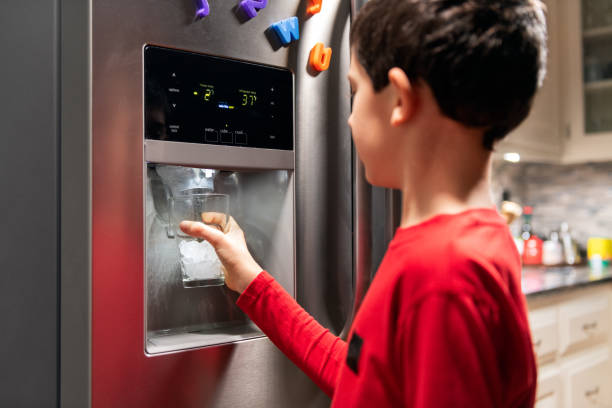Few things are as frustrating as reaching for ice on a hot day, only to find your machine empty. An ice maker is a convenience we often take for granted until it stops working. If you’re currently facing this problem, especially if your Whirlpool ice maker is not working, don’t panic!
At Complete Appliance Care, Inc., we understand how essential a reliable ice maker is to your daily routine. The good news? Many common ice maker problems can be fixed with simple DIY troubleshooting steps no need to call a technician just yet. This comprehensive guide will walk you through the most frequent issues and provide clear, easy-to-follow solutions to get your automatic ice maker back up and running. With the right care, you’ll enjoy a steady supply of fresh ice again in no time.
The Essential First Steps: A Quick Checklist
Before diving into complex fixes, start with these fundamental checks. You’d be surprised how often a minor oversight is the culprit!
Is the Ice Maker Turned On?
This might seem obvious, but it’s the most common reason for a refrigerator not making ice.

- Check the Control Arm/Shutoff Switch: Most refrigerator ice makers have a wire shutoff arm (also called a “feeler arm”) or a small ON/OFF switch. This arm automatically moves up to stop production when the bin is full. If the ice bin was recently removed or if items in the freezer shifted, the arm might have been accidentally bumped up into the OFF (stop) position.
- The Fix: Gently push the wire arm down or flip the switch to the ON (run) position. Listen for a “click” to ensure it’s fully engaged.
Is the Freezer Temperature Correct?
The freezer’s temperature is critical for successful ice production.
- Check the Temperature: Your freezer should be set to 0°F (-18°C) for the ice maker to function properly. Temperatures above 5°F (-15°C) can significantly slow or completely stop ice making.
- The Fix: Use a thermometer to verify the temperature. If it’s too warm, lower the setting and wait 24 hours for the appliance to stabilize before checking ice production again.
Check for an Ice Jam or Blockage
Ice makers can sometimes get stuck in the middle of a harvesting cycle.
- Inspect the Ejector Arm and Mold: Look for any ice cubes jammed in the ejector arm or large ice clumps sticking to the mechanism. This is a frequent issue if the freezer is too cold or if ice isn’t being used regularly.
- The Fix: Unplug the refrigerator first. Carefully use a plastic utensil (never metal!) to dislodge any stuck ice. If there’s a significant buildup, you may need to empty the bin and allow the ice maker to fully defrost naturally.
Water Supply and Filter Issues: The Flow of Ice
If the ice maker is on and the freezer is cold enough, the next major area to investigate is the water flow. Your ice maker needs a steady, unimpeded supply of water to fill the ice mold.
Is the Water Line Kinked or Pinched?
The water supply line runs from your home’s main water source to the back of the refrigerator.
- Check the Line:Gently pull your refrigerator out from the wall. Inspect the 1/4″ water supply line (usually made of copper or PEX tubing) for any sharp bends, kinks, or pinches, especially where it runs behind the unit.
- The Fix: Carefully straighten the line to restore proper water pressure and flow. Be sure not to push the refrigerator too far back against the wall, as this can easily kink the water line again.
When Was the Water Filter Last Replaced?
A clogged water filter is one of the most frequent causes of a Whirlpool ice maker not working or making small ice cubes. The water for the ice maker runs through this filter.
- Check the Filter Status: Most refrigerators recommend replacing the water filter every 6 months, or when the filter indicator light comes on. Over time, the filter collects sediment and impurities, causing the water flow to the ice maker to slow to a trickle.
- The Fix: Purchase and install a new, genuine replacement filter specific to your refrigerator model.
- Flush the System: After installing a new filter, you must flush the system. Dispense 2-4 gallons of water through the door dispenser (if applicable) to remove trapped air and carbon dust from the new filter. Air in the lines can cause slow flow and hollow cubes.
The Frozen Fill Tube Dilemma
If your ice maker is trying to cycle but no water is entering the tray, the fill tube may be frozen.
Is the Ice Maker Fill Tube Frozen?
The fill tube is the small spout that directs water into the ice maker tray (or mold).
- Locate the Tube: The fill tube is typically a small white or clear tube located just above or behind the ice maker assembly. If you can see a visible plug of ice blocking the opening, it’s frozen. This often happens if the water inlet valve leaks slightly or if the freezer is too cold.
- The Fix:
- Unplug the refrigerator for safety.
- Use a hair dryer on a low, warm setting to gently thaw the frozen plug. DO NOT use high heat and be careful not to hold it too close, as you could damage the plastic components.
- Alternatively, use a turkey baster to squirt a small amount of warm water into the tube to melt the ice.
- Once thawed, plug the fridge back in.
The Ice Maker Reset: Your Magic Button
When all simple checks fail, a power cycle or reset can clear minor electronic glitches and force the ice maker to restart its cycle.
How to Reset a Whirlpool Ice Maker
- Look for a Reset Button: Many modern ice makers, especially newer Whirlpool models, have a small reset button located on the bottom of the ice maker module. It might be recessed and require a pen or thin tool to press.
- Perform the Reset: Press and hold the reset button for about 5-10 seconds until you hear a series of tones or until the ice maker begins a test cycle (ejecting/dumping).
- Power Cycle (The Hard Reset): If you can’t find a reset button, the next best thing is to perform a full power cycle. Unplug the refrigerator from the wall outlet for at least 5 minutes, then plug it back in. This completely resets the appliance’s control board. Give the unit a few hours to cool down and attempt to make its first batch of ice.
When to Call a Professional
If you’ve meticulously followed all the troubleshooting steps above—checking the power, temperature, water line, filter, jams, and performing a reset—and your ice maker still won’t work, the issue is likely a component failure.
Common component failures that require professional service include:
- Defective Water Inlet Valve: This electrical valve opens to let water into the ice maker. If it fails to open, no water enters the mold. If it fails closed, it may cause the fill tube to freeze.
- Faulty Ice Maker Module: The main assembly (containing the motor, ejector, and electronic control board) may have failed. Running the manual diagnostics (if your model has this feature) can help confirm this.
- Wiring Harness Issues: Especially in side-by-side or French door models where the ice maker is in the door, wires can wear out or break at the door hinge over time.
For these more complex refrigerator repairs, it’s best to consult your owner’s manual and contact an appliance repair professional certified for your brand (like Whirlpool appliance repair) to prevent causing further damage.
Conclusion:
Fixing an ice maker may seem like a hassle, but as you’ve seen, most issues come down to just a few key areas: power, temperature, water flow, and maintenance. With the right knowledge and a bit of patience, you can often solve the problem yourself—saving time and money. Whether you’re dealing with a Whirlpool ice maker not working or just noticing slower ice production, these simple steps empower you to take control. Remember, routine maintenance like filter changes and keeping the freezer at the right temperature can prevent most problems before they start. And if all else fails, don’t hesitate to call in a pro—sometimes, a small repair today saves you from a big replacement tomorrow. So, stay proactive, stay cool, and keep the ice flowing!
FAQs
1. Why isn’t my Whirlpool ice maker working?
Check the filter, fill tube, and ice maker module.
2. How often should I change the water filter?
Every 6 months.
3. Can a cold freezer stop ice production?
Yes, if it’s too cold and freezes the fill tube.
4. Is it safe to thaw the fill tube with a hair dryer?
Yes, on low heat and with caution.
5. Why is my ice maker slow?
Likely due to a clogged filter or low water pressure.
